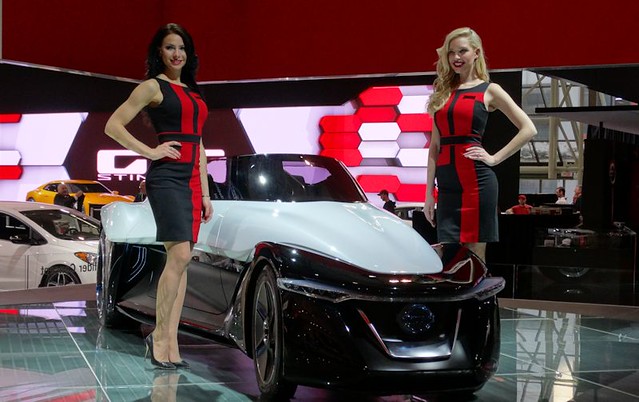 |
| Photo Credit: Nissan |
Not even five years since being revealed to the public, one of the most profoundly distinct designs to have emerged for modern auto racing has become the subject of innovation, envy and contention. This month, Don Panoz, CEO of DeltaWing Technology Group and Japanese automaker Nissan have reignited a dispute over the ownership of a breakthrough engineering philosophy for modern automobiles on the race track as well as on the street.
When the IndyCar Series welcomed proposals to visions of American open wheel racing for the 2012 season, a jet plane-like concept premiered generating an instant sensation. The radical DeltaWing presented an ultra-aerodynamic shape and lightweight construction boasting high-speed potential with less horsepower. A narrow front wheel track and the lack of downforce enhancing devices such as the conventional rear wing found on most modern race cars created a thought-provoking possibility to IndyCar competition that resulted in both reverence as well as criticism citing whether the design was too outrageous. While IndyCar did not choose the DeltaWing (selecting Dallara as the chassis constructor for the 2012 season), the innovative, bold vehicle idea proved too remarkable to be denied a chance of survival. Instead of the ovals and road courses of IndyCar racing, the DeltaWing design was adopted to sports car competition where it made its debut at the 2012 24 Hours of Le Mans within a special 56th garage spot reserved for team experimental vehicles. A turbocharged, gasoline direct-injected 1.6-liter Nissan engine similar to the production powerplant found in the Juke propelled the DeltaWing in its first major field test. The 2012 Nissan DeltaWing machine would again appear at the American Le Mans Series' Petit Le Mans at Road Atlanta owned by the wealthy motorsport mogul Don Panoz.
 |
| Photo Credit: Nissan |
The limited 2012 outing for the vehicle ended with the Japanese auto manufacturer and the principals behind DeltaWing going their separate ways. However, by the end of 2013, both entities involved in the 2012 Le Mans entry each staked claim to the design. A company related to the vehicle's original developer, DeltaWing remains a regular participant in the IMSA WeatherTech SportsCar Championship. Following their involvement with the so-called Project 56 effort at Le Mans in 2012, Nissan developed explored similar vehicle design theories to the DeltaWing with the BladeGlider concept and the Nissan ZEOD RC competition car entered at the 2014 24 Hours of Le Mans event. Don Panoz has been moving to prevent Nissan from using details of the DeltaWing design is protected intellectual property. He filed a cease-and-desist order against Nissan shortly after the BladeGlider concept was unveiled in late 2013. Interesting enough, Ben Bowlby, the designer credited to the original DeltaWing, has been part of the creative team for the Nissan project cars (He was also behind the design of the Nissan GT-R NISMO LM car that competed at the 24 Hours of Le Mans in 2015).
 |
| Photo Credit: Chris Nagy |
Fast-forwarding to August of 2016, Nissan emerged with a revised version of the BladeGlider concept car updated as a three-passenger, fully-electric demonstration automobile in Rio de Janiero. One of two examples of the Nissan BladeGlider in Brazil is a functioning model operating with a pair of 130-kilowatt electric motors. The new version of the Nissan BladeGlider exhibiting what the auto company calls a "... on-going commitment to the development of zero-emission vehicles and new automotive technologies including autonomous drive systems and connectivity."
On Thursday, less than two weeks after Nissan revealed the latest evolution of their BladeGlider concept, DeltaWing Technology Group has published a release again staking a personal claim to design characteristics that appear to be shared between the Nissan BlideGlider and original DeltaWing concept. "We're pleased though not surprised Nissan publicly recognized the innovation and viability of the DeltaWing™ design," said the CEO for DeltaWing Don Panoz reasserting that his automotive group are the rightful holders to any vehicle sporting the likeness to the unique, functional appearance. Panoz acknowledged the partnership with the Japanese automaker that initially brought the DeltaWing shape to the 2012 24 Hours of Le Mans but goes to lengths to state they lack the intellectual property. As Nissan displays their newest BladeGlider, DeltaWing expresses the intent to have a street-legal variant of their racing vehicle.
Along with proclaiming ownership of the design characteristics used on their competition sports car, DeltaWing has provided a rendering of a two-passenger DeltaWing GT road car. The company plans to have a prototype of the GT ready before the end of this year. Along with the two-passenger model, a four-passenger DeltaWing street-legal vehicle is also slated. DeltaWing has expressed the desire to explore multiple powertrain options with the car with small internal combustion engines, hybrid electric-assisted power units as well as all-electric versions potentially attached to their production lineup.
 |
| Photo Credit: DeltaWing Technology Group |
For the time-being, protection of the design attributes shared with the DeltaWing and Nissan vehicles is still under a legal dispute related to the 2013 actions launched by Panoz. At this point, it is uncertain what kind of resolution could be arrived at between the two parties that could see a positive move forward for innovative automotive engineering.

Comments
Post a Comment